June 6th, 2018 “In wheat Kansas can beat the world” – Topeka Daily Capital, October 12, 1888.
Venture outside the Kansas cities and you will find one of the state’s greatest assets: its farmland. During this time of year, many of the rolling fields are starting to turn gold as farmers prepare for Kansas’ upcoming wheat harvest. Kansas is the nation’s leader in the production of winter wheat – wheat planted in the fall and harvested during the late spring and summer – with eight to twelve million acres of winter wheat planted in the state every year.
As we look forward to the upcoming harvest season, let’s take a look at some photos of wheat harvest in Kansas from the early to mid twentieth century.
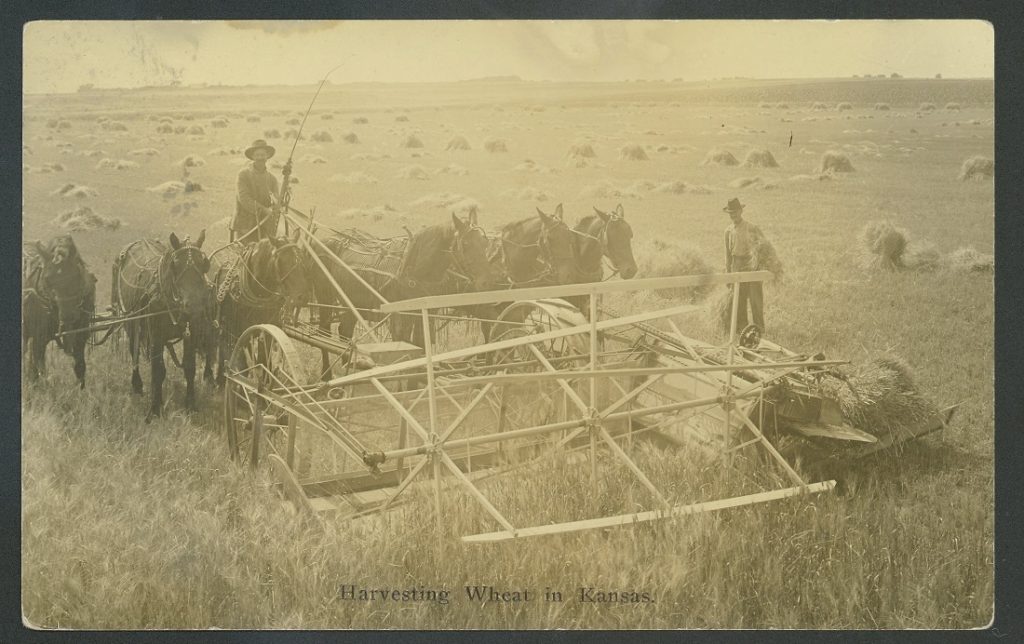
Harvesting wheat in Kansas, 1910s.
Photograph by L. M. Ulmer, Abbyville, Kansas. Call Number: RH PH P2605.
Click image to enlarge (redirect to Spencer’s digital collections).
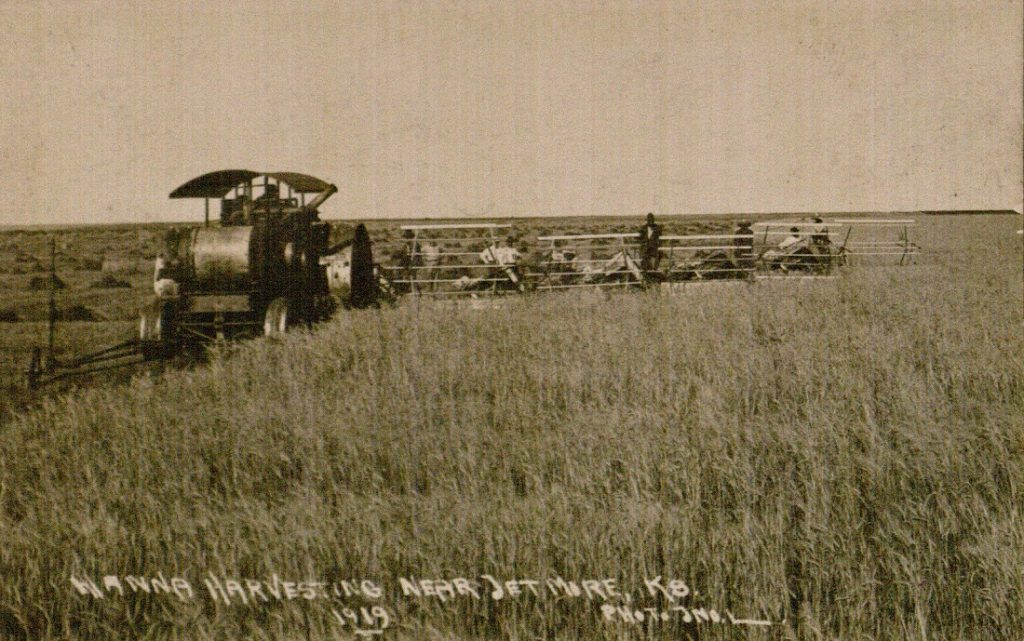
Harvesting wheat near Jetmore, Kansas, 1919.
Call Number: RH PH P1488.2. Click image to enlarge.
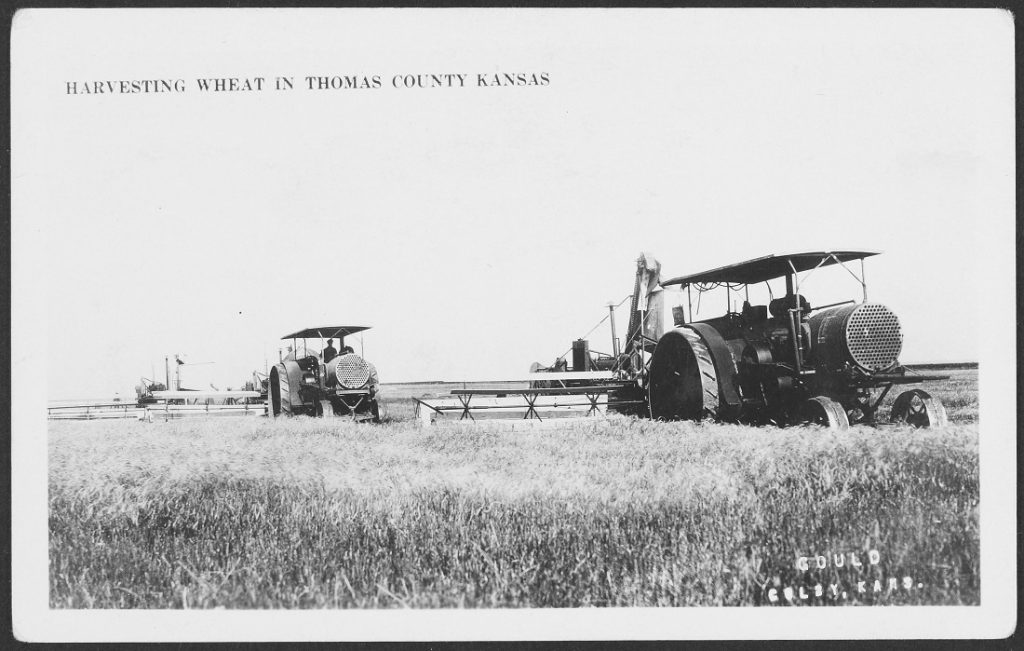
Harvesting wheat in Thomas County, Kansas, circa 1922.
Photograph by George Gould, Colby, Kansas. Call Number: RH PH P1130.1.
Click image to enlarge (redirect to Spencer’s digital collections).
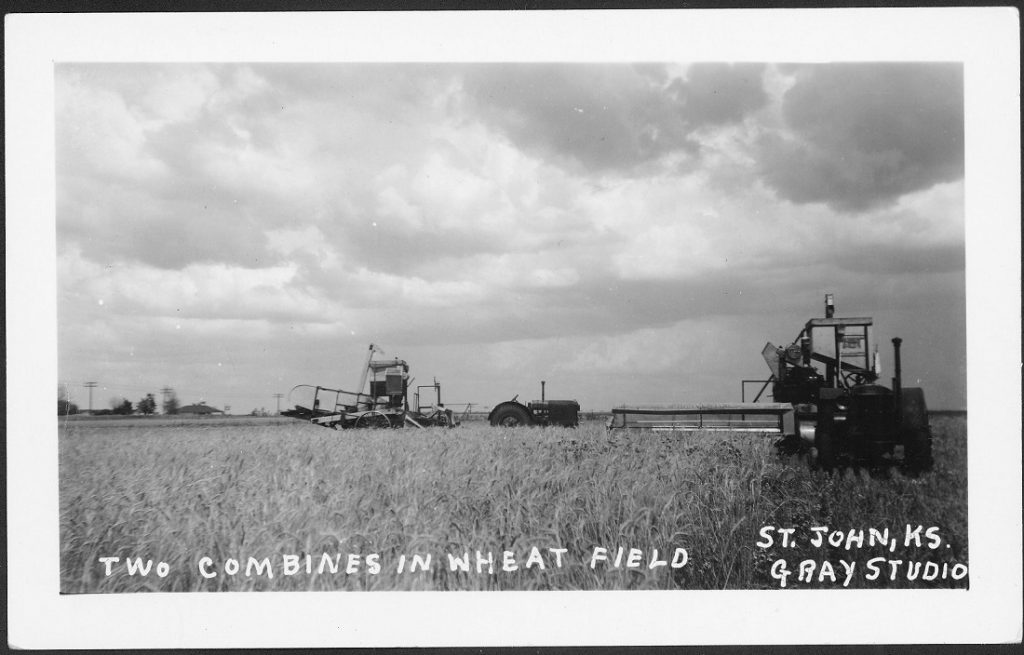
Two combines in a wheat field, St. John, Kansas, between 1945 and 1949.
Photograph by William Gray. Call Number: RH PH P1101.
Click image to enlarge (redirect to Spencer’s digital collections).
Even as the times and technology change, one thing remains constant: Kansas continues to lead the way when it comes to wheat production!
Emily Beran
Public Services
Tags: Emily Beran, Farms, Kansas, Kansas Collection, photographs, Wheat, Wheat harvest
Posted in Kansas Collection |
No Comments Yet »
May 22nd, 2018 This blog post has been a long time coming. I actually started writing about MS A7 last fall. I wanted to do a simple post that talked about this manuscript and highlighted its interesting watercolor and ink drawings. However, in the preliminary stages of my research, the information I found brought up a series of questions that I have been attempting to answer for the past few months. Here is a peek at what I have learned so far!
Prediche sul nome di Gesu is a late 15th to early 16th-century Italian manuscript. The manuscript features a series of sermons on the name of Jesus by Saint Bernardinus of Siena (San Bernardino in Italian). The content of the manuscript is pretty straightforward; it is the images that prompted serious questions for me. There are several full-page drawings that feature a monk involved in a series of activities that are confusing at best (and completely macabre at worst).

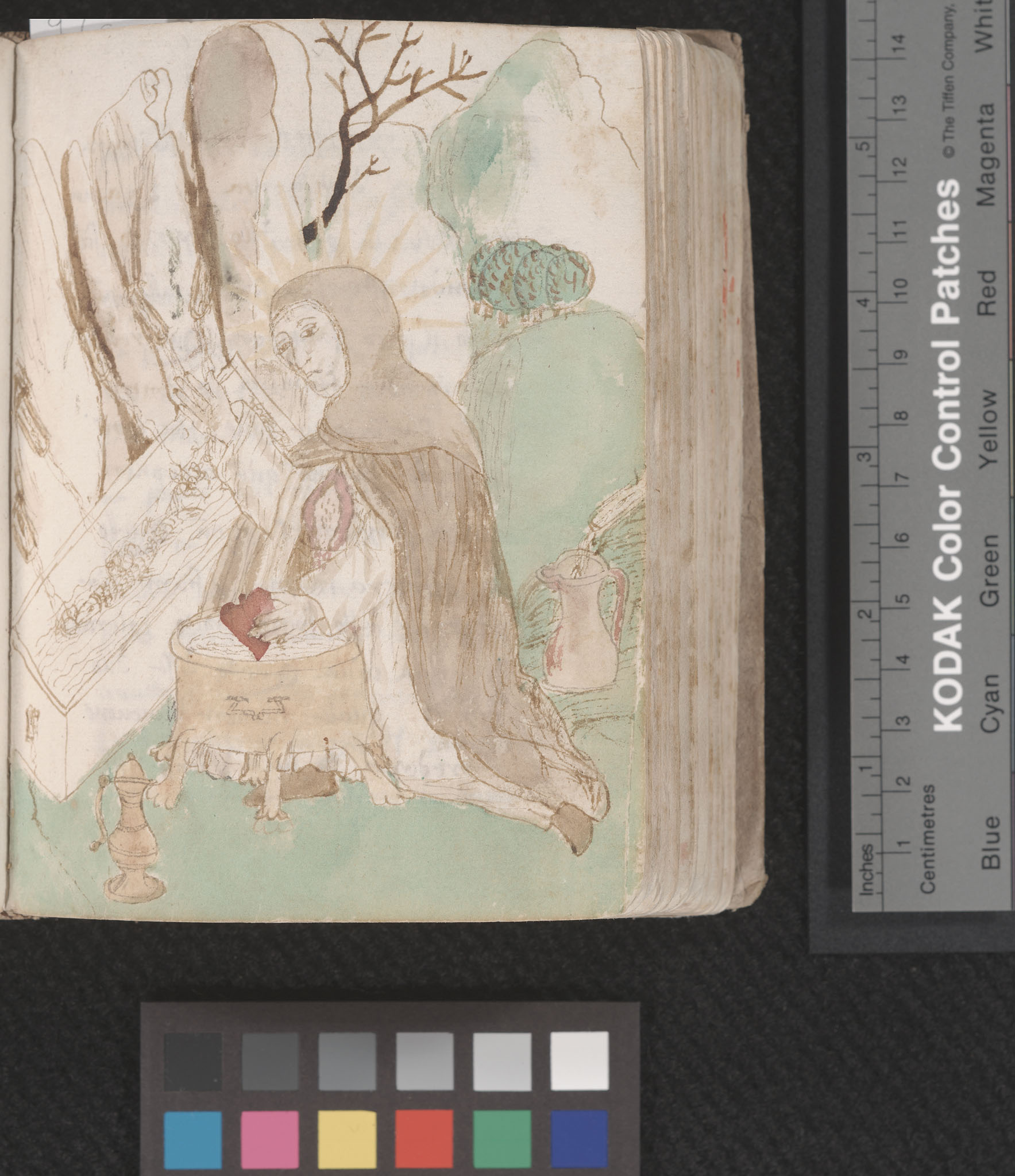
With the open chest wound and heart in hand, the image on the right was the one that initially piqued my interest
in this manuscript. How was the monk alive without his heart? Did the seeming improbability of what was happening
in the image mean this was the depiction of a vision or metaphor within the text? Folio 81r (left) and 88r (right)
from Saint Bernardinus of Siena’s Prediche sul nome di Gesu, Italy, circa late 15th-16th century.
Call Number: MS A7. Click images to enlarge.
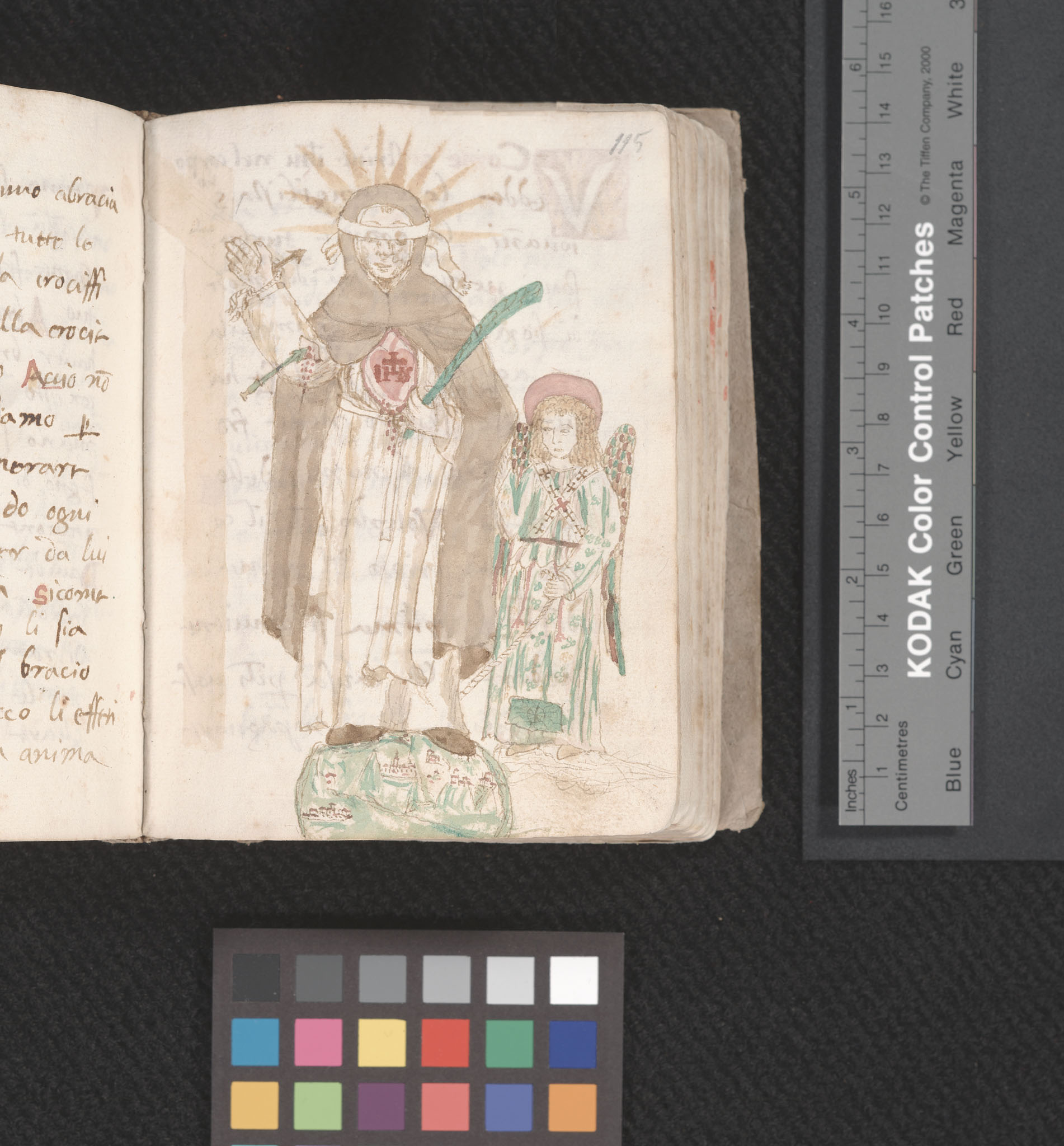
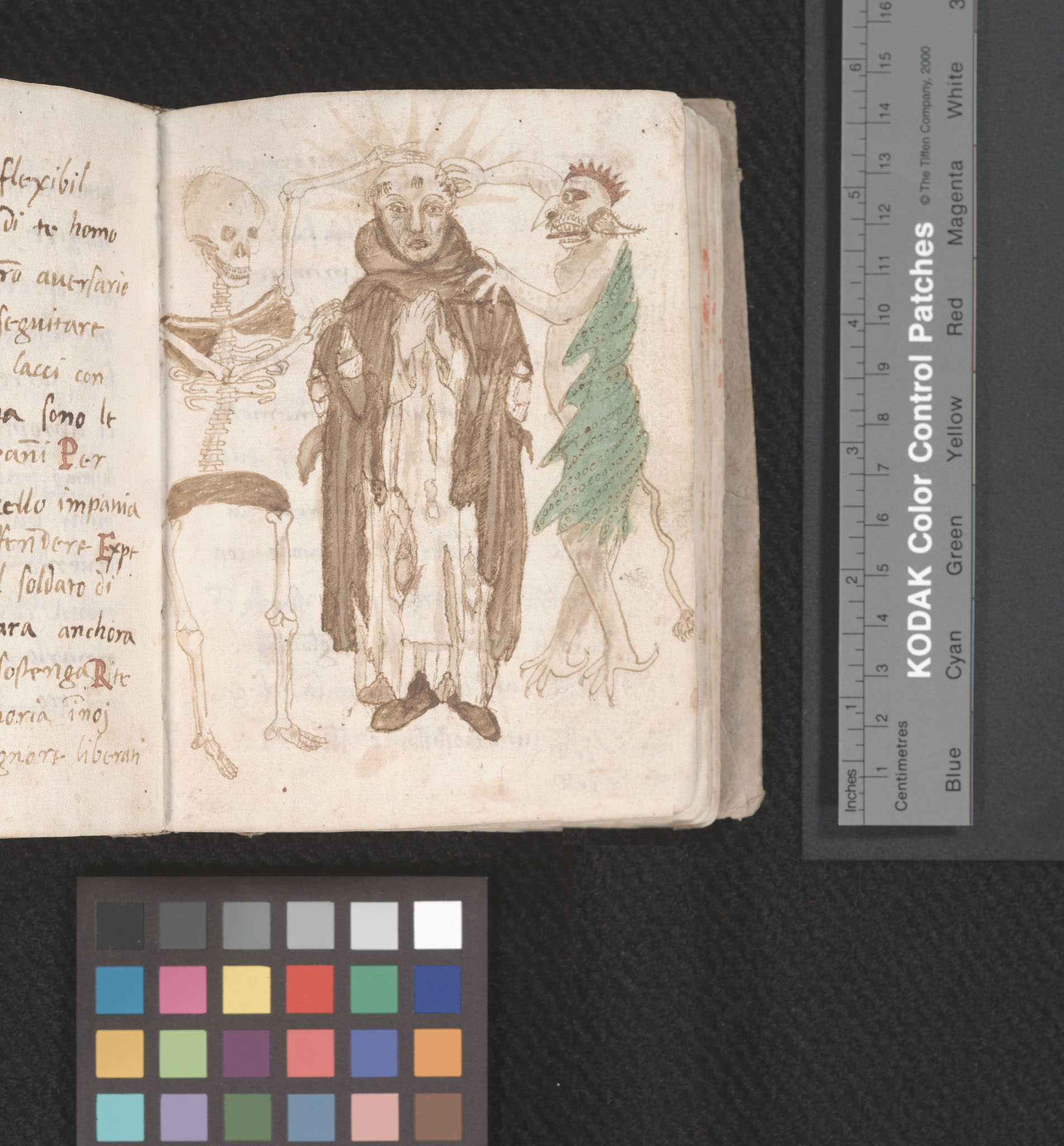
The image on the left has prompted so many questions. How does this image relate to the previous images of the monk?
Is it even supposed to be the same monk? Why is he blindfolded? Folio 115r (left) and 137r (right) from Saint Bernardinus
of Siena’s Prediche sul nome di Gesu, Italy, circa late 15th-16th century. Call Number: MS A7. Click images to enlarge.
Were these images meant to depict scenes from the life of San Bernardino? A series of visions the saint experienced? Preliminary research on the life of San Bernardino seemed to indicate that neither one of those conclusions was likely. I then turned to our records concerning the manuscript – accession files, catalogue entries, bookseller correspondence, etc. The lack of concrete information and answers in those records solidified my growing belief that little to no serious research had ever been done on this manuscript (not unusual with collections the size of ours). It became clear that if I wanted answers, I was going to have to find them myself. I had a hunch that the images were related to the text, possibly even very literal depictions of passages in the sermons. However, without any significant knowledge of Italian, I knew I needed quite a bit of help.
The next steps in my research process demonstrate just how lucky we are to have the amazing faculty we do at KU. First and foremost, our Special Collections curators, Karen Cook and Elspeth Healey, provided insight, access to files, suggestions of where to look next, and beginning translation help. The next step was to find someone to more fully translate the Italian and provide some more information about the images themselves. This led me to Dr. Areli Marina in the Kress Foundation Department of Art History here at KU.
Dr. Marina’s translation work and insight have helped me immensely. With her assistance, I have started to get a clearer picture of what is happening in the manuscript (my initial hunch seems to be on the right track). However, with each new bit of information, more questions continue to arise. For example, do these sermons and images have any connections to certain established monastic communities and their traditions? Hopefully, I will have more answers to share with you all soon!
Emily Beran
Public Services
Tags: early modern manuscripts, Emily Beran, italian manuscripts, medieval manuscripts, mysteries, Prediche sul nome di Gesu, religion, Saint Bernardinus, San Bernardino
Posted in Special Collections |
No Comments Yet »
November 21st, 2017 Happy (early) Thanksgiving, everyone! We hope you all get the chance to enjoy a relaxing few days with your loved ones over the holiday! Please remember that the Spencer Research Library will be closed from Thursday to Sunday this week.
We invite you to take a moment and reflect on this thoughtful and introspective poem by award-winning poet, Linda Pastan. Entitled Home for Thanksgiving, the poem comes from her book, Setting the Table.
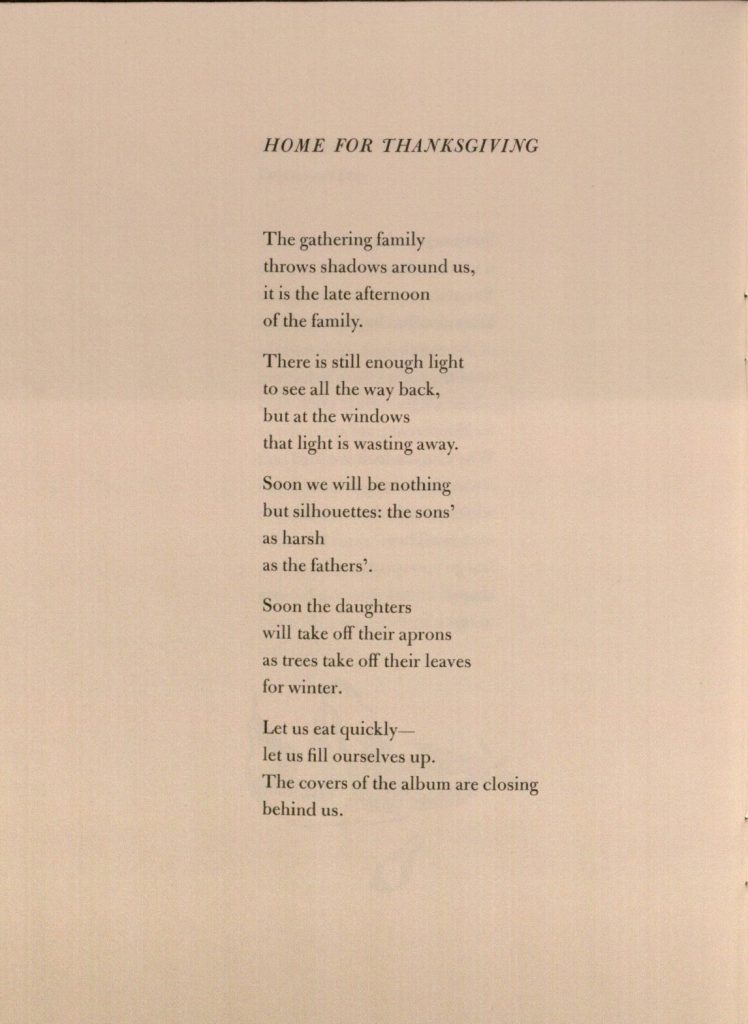

“Home for Thanksgiving” by Linda Pastan from her collection, Setting the Table: Poems. Washington, D.C. ; San Francisco: Dryad Press, [©1980]. Kenneth Spencer Research Library, University of Kansas. Call #: C9301. Click images to enlarge.
Emily Beran
Public Services
Tags: " Linda Pastan, "Home for Thanksgiving, Autumn, Emily Beran, Poetry, Setting the Table: Poems, Thanksgiving
Posted in Special Collections |
No Comments Yet »
October 13th, 2017 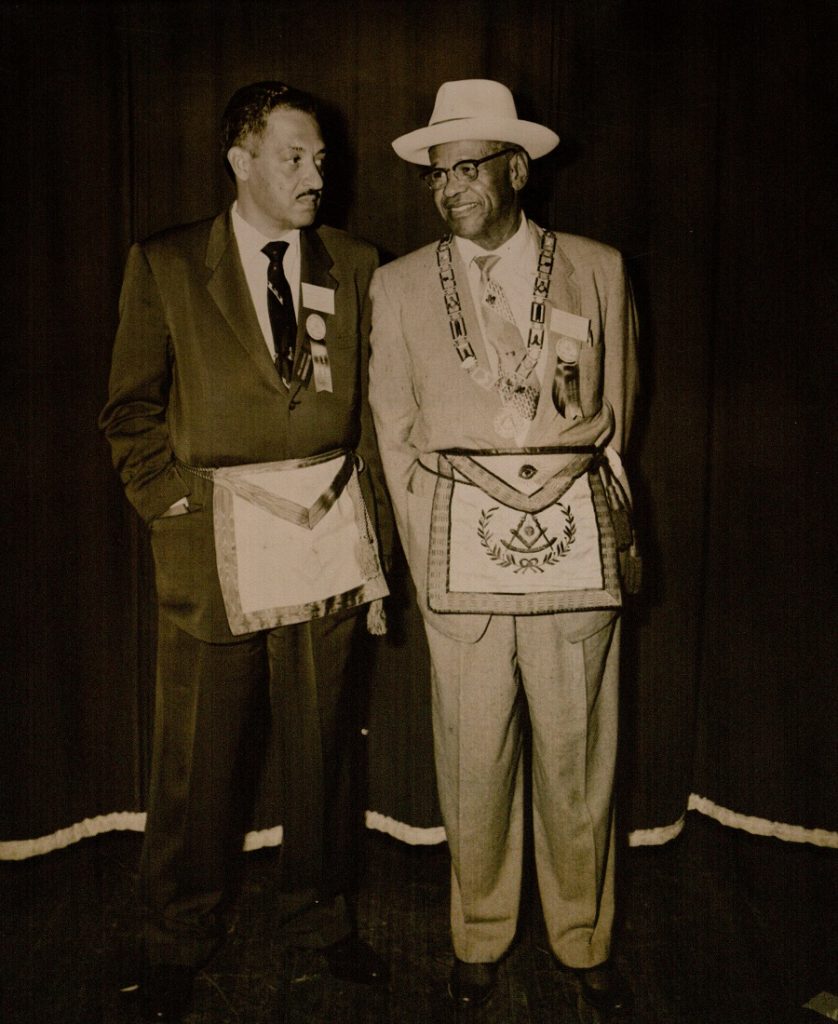
Photograph of Thurgood Marshall (left) and an unidentified man, undated.
As shown by the apron he’s wearing, Marshall was a member of
Prince Hall Masons. J. B. Anderson Papers and Photographs.
Call Number: RH MS 1230. Click image to enlarge.
In recognizing the humanity of our fellow beings, we pay ourselves the highest tribute.
– Thurgood Marshall, Supreme Court Justice, 1967-1991
In 1967, Thurgood Marshall became the first African American justice appointed to the Supreme Court of the United States. Before his tenure on the Supreme Court, Marshall was a renowned attorney and founder of the NAACP Legal Defense and Educational Fund, and he championed civil rights through his work. One of these cases, State of Connecticut v. Spell, is the topic of the new movie Marshall. The film’s national release date – October 13th – closely coincides with the 50th anniversary of Marshall’s swearing in as a Supreme Court Justice (October 2, 1967).
Inspired by the release of Marshall, and in honor of the life and legacy of this remarkable man, Spencer Research Library invites you to explore our collections related to one of Thurgood Marshall’s most famous court cases: Brown v. Board of Education, the landmark case that ended racial segregation in schools.
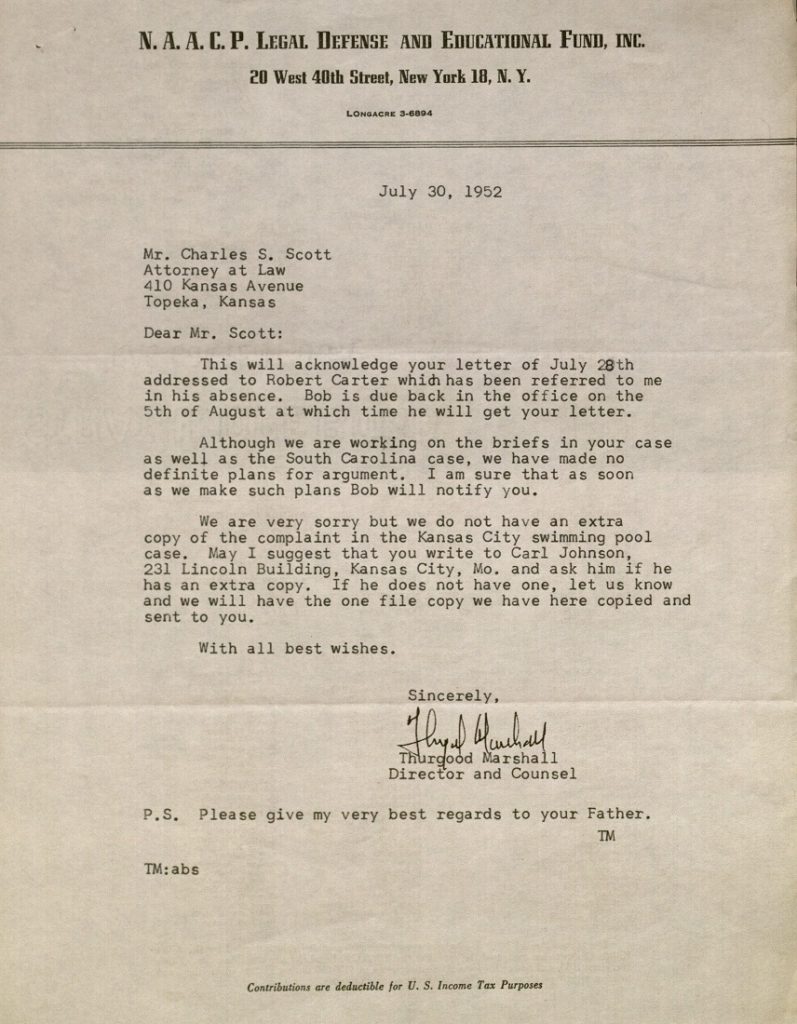
Letter from Thurgood Marshall to Charles S. Scott, July 30, 1952.
Charles S. Scott Papers. Call Number: RH MS 1145.
Click image to enlarge.
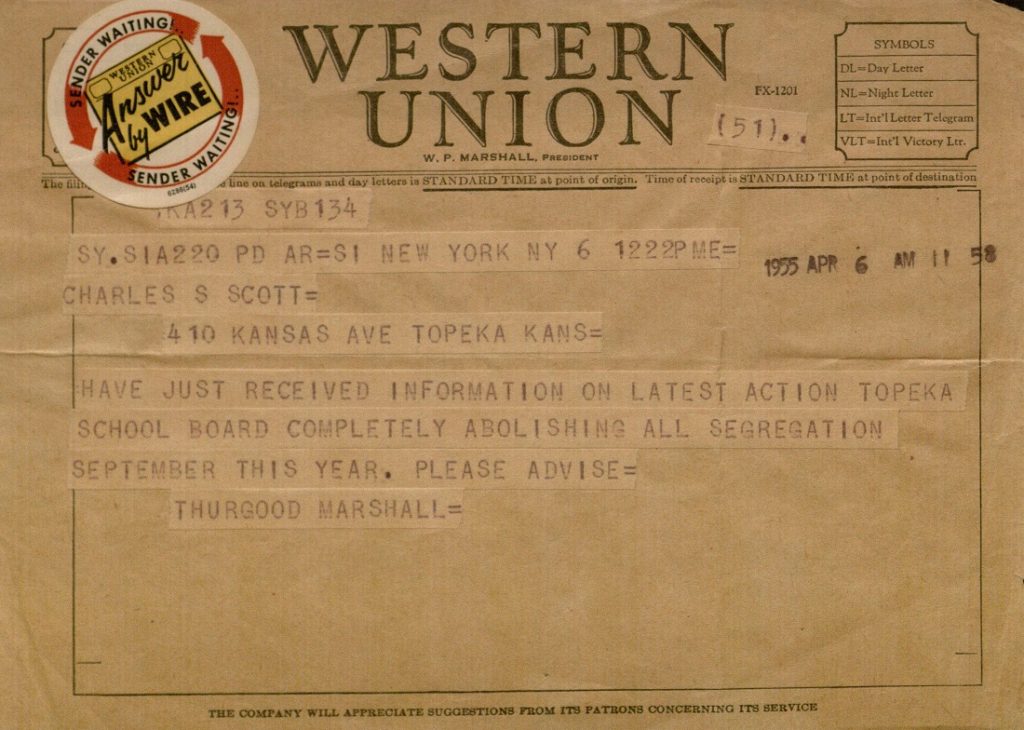
Telegraph from Thurgood Marshall to Charles S. Scott, April 6, 1955.
Charles S. Scott Papers. Call Number: RH MS 1145. Click image to enlarge.
Charles S. Scott papers: Charles S. Scott was a prominent lawyer in Topeka, Kansas, and served as the attorney for one of the plaintiffs in the original Brown v. Board of Education Kansas case. Included in this collection are documents and correspondence from his work on Brown v. Board of Education, as well as materials related to his legal career and personal life.
J. B. Anderson papers and photographs – J. B. Anderson was a Topeka, Kansas, resident and active community member. He was also a popular photographer who documented the local African American community and their experiences in Topeka. In the photographs of this collection are a few photos of Thurgood Marshall at a Chicago-area Masonic event.
Brown Foundation for Educational Equity, Excellence and Research records – The Brown Foundation was established by community members in 1988 as a tribute to those involved in Brown v. Topeka Board of Education case. The Brown Foundation continues to provide support educational opportunities throughout the world. After years of work, the Brown Foundation also successfully secured designation as a National Historic Landmark for Monroe School – a key site in the history of the Brown v. Board of Education case. The site was later established as a unit of the National Park Service.
Emily Beran
Public Services
Tags: Brown v. Board of Education, Charles Scott, correspondence, Emily Beran, Kansas Collection, photographs, Prince Hall Masons, Telegraph, Thurgood Marshall
Posted in Kansas Collection |
No Comments Yet »
September 22nd, 2017 “This book while today may not be of much value to me, I hope will in future years become priceless.”
– Diary of Thomas C. Key, 1918
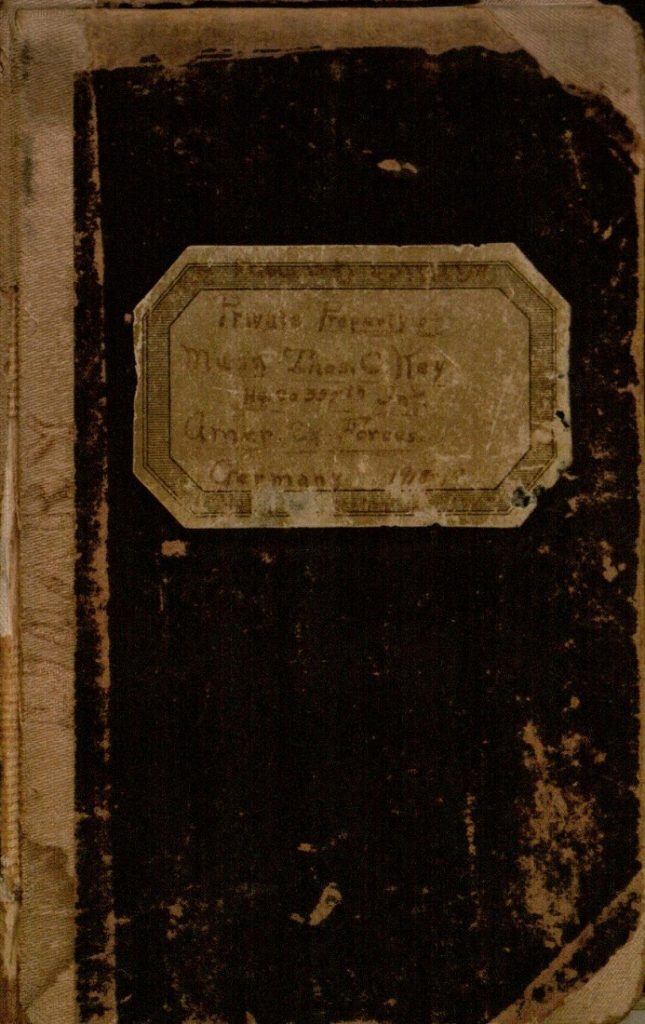
The cover of Thomas C. Key’s diary.
Call Number: RH MS B75.
Click image to enlarge.
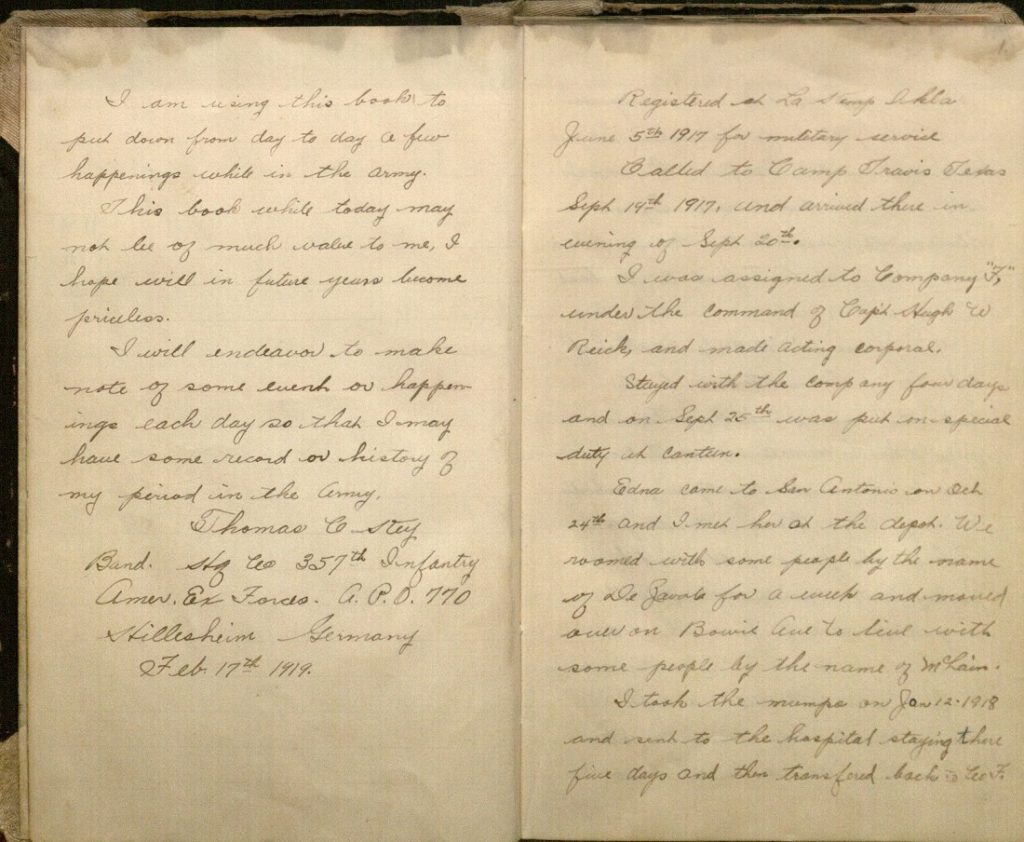
The first page of entries in Thomas Key’s World War I diary.
Call Number: RH MS B75. Click image to enlarge.
Thomas C. Key was a member of Company F in the 357th infantry division of the American Expeditionary Forces from 1917 to 1919. In March 1918 he became a member of the infantry band before being transferred overseas. He was stationed in parts of France and Germany from 1918 until his discharge in June 1919. During his time in the Army, he filled this diary with daily updates – concert preparation details; the receipt of a letter from his wife, Edna; the daily weather, etc. – so that in later years he would have a record of his military service.
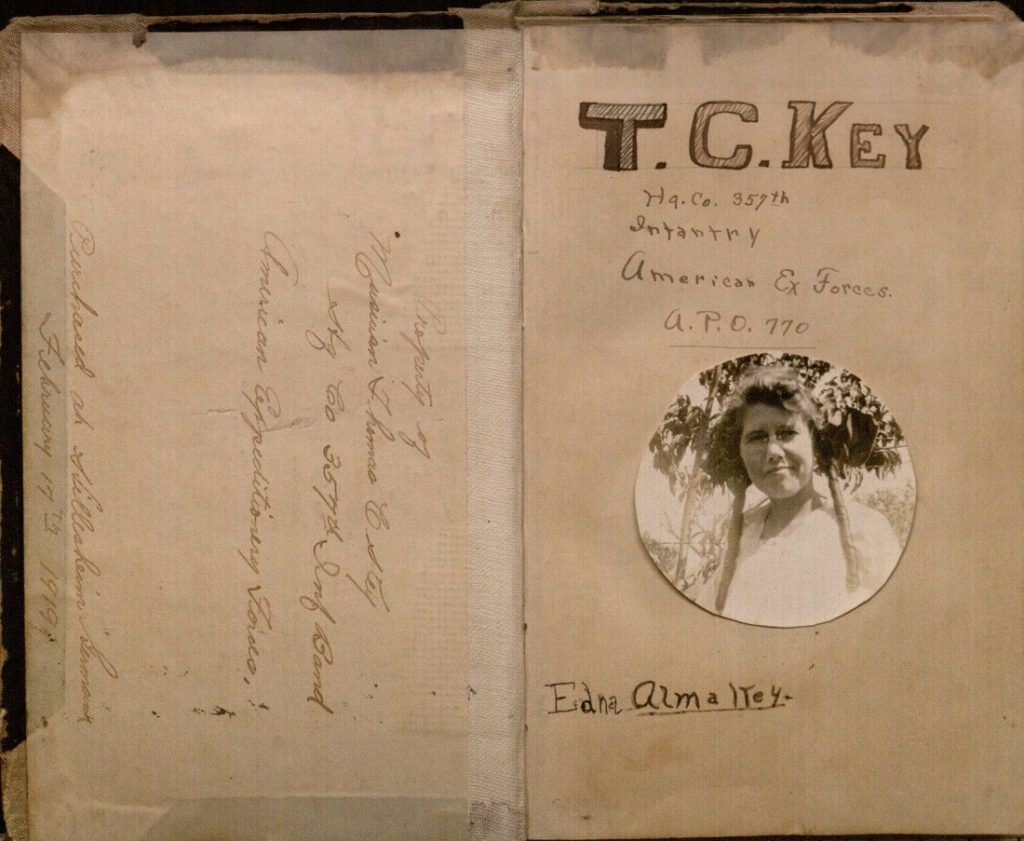
The title page of Thomas Key’s World War I diary with a photograph
of his wife, Edna. Call Number: RH MS B75. Click image to enlarge.
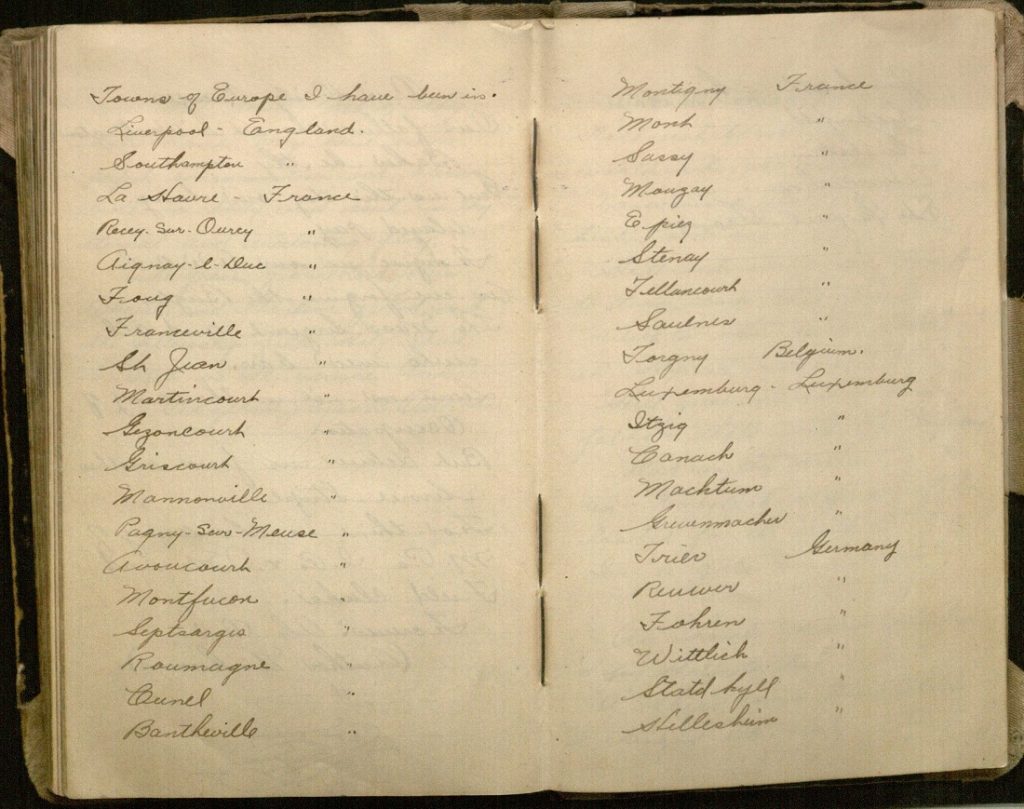
Key’s list of the towns he visited in Europe during World War I.
Call Number: RH MS B75. Click image to enlarge.
In addition to Key’s entries from his time in Europe, the diary includes entries from his life after he returned home as well as a list of addresses for his bandmates, some of his family history details, and his transcriptions of military poems, essays, and burial rites.
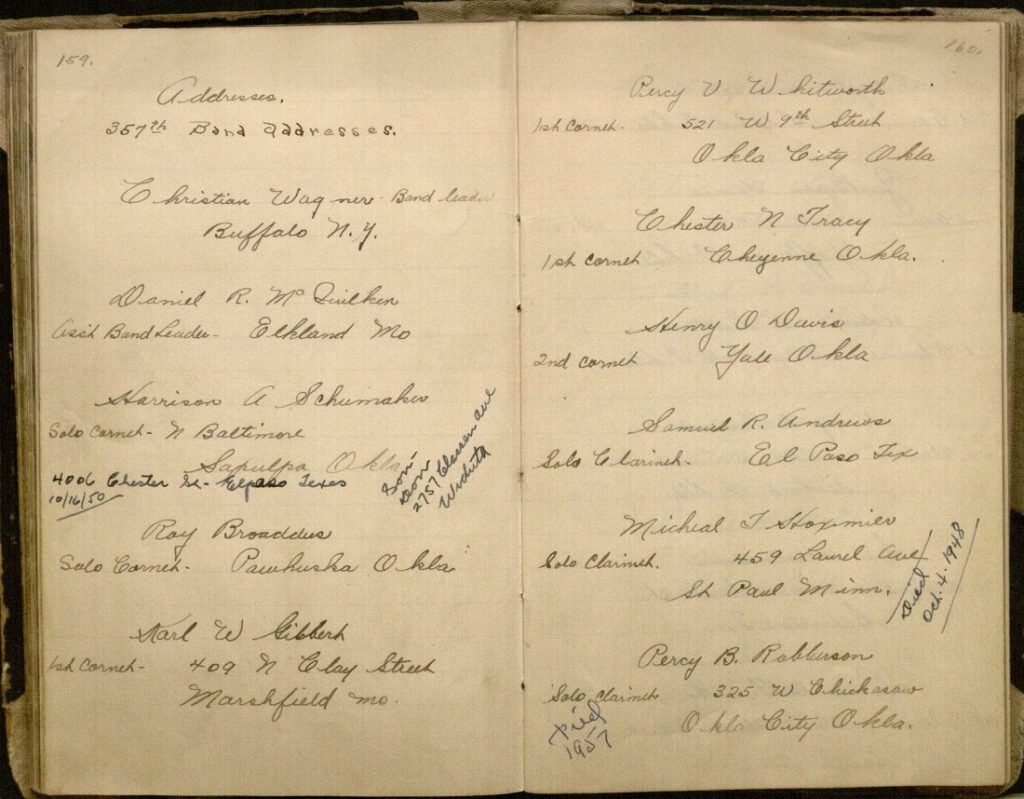
The civilian addresses of Key’s bandmates.
Call Number: RH MS B75. Click image to enlarge.
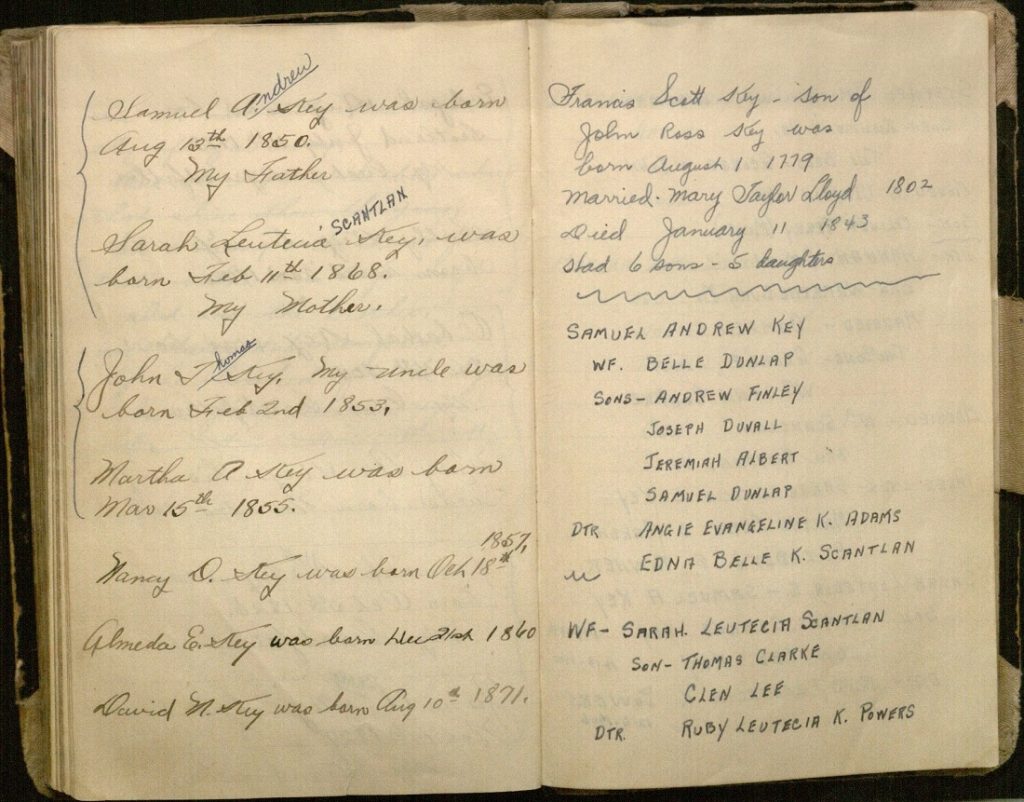
Family history in the diary, including information about Thomas’s relative
Francis Scott Key, who wrote the Star-Spangled Banner.
Call Number: RH MS B75. Click image to enlarge.
Emily Beran
Public Services
Tags: Diary, Emily Beran, Francis Scott Key, Thomas C. Key, World War I
Posted in Kansas Collection |
No Comments Yet »



















